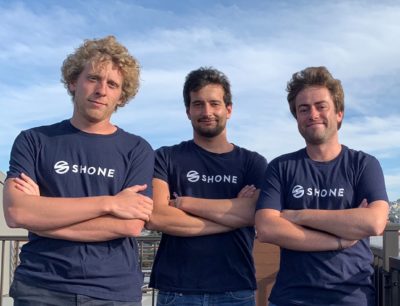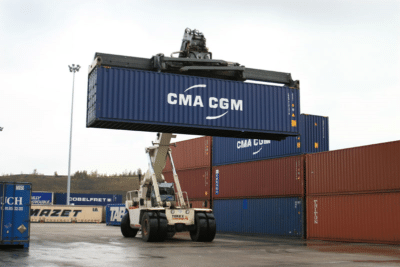It started as friends hacking a radio-controlled boat over a weekend for fun. What happened next is classic Silicon Valley: Three childhood buddies parlay robotics and autonomous vehicle skills into an autonomous ship startup and cold-call the world’s third-largest cargo shipper.
San Francisco-based Shone — founded by Parisian classmates Ugo Vollmer, Clement Renault and Antoine de Maleprade — has made a splash in maritime and startup circles. The company landed a pilot deal with shipping giant CMA CGM and recently won industry recognition.

Shone aims to modernize shipping. The startup applies NVIDIA GPUs to a flood of traditional cargo ship data such as sonar, radar, GPS and AIS, a ship-to-ship tracking system. This has enabled it to quickly process terabytes of training data on its custom algorithms to develop perception, navigation and control for ocean freighters. The company has added cameras to offer better seafaring object detection as well.
“The first part is packaging all of the perception so the crew can make better decisions,” said Vollmer, the company’s CEO, previously an autonomous vehicle maps engineer at Mapbox. “But there’s tons of value of connecting communications from the ship to the shore.”
Cargo ships are among a wave of industries, including locomotives, joining the autonomous vehicle revolution.
Shone is a member of NVIDIA Inception, a virtual accelerator program that helps startups get to market faster.
GPUs Set Sail
Founded in 2017, Shone has expanded to eight employees to navigate seafaring AI. Its NVIDIA GPU-powered software is now deployed on several CMA CGM cargo ships in pilot tests to help with perception for ship captains.
“What is particularly interesting for CMA CGM is what artificial intelligence can bring to systems on board container ships in terms of safety. AI will facilitate the work of crews on board, whether in decision support, maritime safety or piloting assistance,” said Jean-Baptiste Boutillier, deputy vice president at CMA CGM.
It didn’t come easy. The trio of scrappy entrepreneurs had to hustle. After hacking the radio-controlled boat and realizing they had a model for an autonomous boat, they raised $200,000 in friends-and-family money to start the company.
Next they got accepted into Y Combinator. Shone’s partnership with CMA CGM, which operates 500 ships worldwide, came as the team was working as a member of the winter 2018 batch at the accelerator and urgently seeking a pilot to prove their startup’s potential.
Renault and Vollmer recall cold-calling CMA CGM, the surprise of getting an appointment, and going in jeans and T-shirts and underprepared to meet with executives — who were in suits. Despite that, the execs were impressed with the team’s technical knowledge and encouraged them to come back — in six months.
“There is this industry that is moving 90 percent of the products in the world, and the tech is basically from the ‘80s — we were like, ‘What? How is that possible?’” said Renault, who previously worked on autonomous trucks at Starsky Robotics.

Prototype AI Boat
Not to be discouraged by the first meeting, the team decided to buy a real boat to outfit with AI to show CMA CGM just how serious they were. Renault spent $10,000 for a 30-foot boat he located on Craigslist, but the trailer blew a tire on the way back from the Sacramento River delta. Just one more obstacle to overcome, but he got help and got it back to the office.
De Maleprade’s robotics skills came into play next. (“He was building rockets when he was 14 and blowing things up,” Vollmer said.) De Maleprade fitted the boat with a robotic hydraulic steering mechanism. The other two went to work on the software with him, installing a GPU on the boat, as well.
The boat development was sped by training their algorithms on GPU workstations, and the on-board GPUs of the boat enabled inferencing, said de Maleprade.
Three months later, the trio had the autonomous boat prototype ready. They showed off its capabilities to CMA CGM, which was even more impressed. The executives invited them to develop the platform on several of their freighters, which span four football fields in length and transport 14,000 containers from Southern California to China.
“CMA CGM has built its success on strong entrepreneurial values and constant innovations. That is why we decided to allow the Shone team to board some of our ships to develop their ideas and their potential,” said Boutillier.
The founders often sleep on the cargo ships, departing from the Port of Long Beach to arrive in the Port of Oakland, to observe the technology in action and study CMA CGM’s needs.
Synthesizing all the maritime data with various home-brewed algorithms and other techniques to develop Shone’s perception platform was a unique challenge, said de Maleprade, who worked on robotics before becoming CTO at Shone.
“We took a video with a drone to show CMA CGM our prototype boat could offer autonomous navigation assistance for crews. They liked what we had,” said de Maleprade. He says they’re now working on simulation to speed their development timeline.
The Shone team recently finished up at Y Combinator, leaving a strong impression at its Demo Day presentation and with $4 million in seed funding from investors.